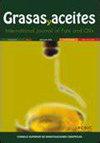探索柑橘种子的生化成分在工业中的应用
IF 1
4区 农林科学
Q4 CHEMISTRY, APPLIED
引用次数: 0
摘要
本研究旨在评估柑橘类种子的生化特征,并根据其生化成分阐明不同品种之间的相关模式。对柑橘种子样本进行提取,并对所得油脂的生化水平进行分析。研究结果表明,包括天堂柑橘、柠檬(L.)Burm.f.、网纹柑橘、C. maxima (Burm.) Merr.和中华柑橘在内的几种柑橘种子在黄酮类化合物、酚酸和类胡萝卜素的组成方面表现出相似性。然而,芳香挥发性化合物在不同品种之间存在差异,没有明显的相似模式。N -羟色胺化合物在不同品种之间表现出显著差异;而脂肪酸化合物在柑橘(Citrus latifolia)和柠檬(C. limon (L.) Burm.f.)之间表现出相似性。本文章由计算机程序翻译,如有差异,请以英文原文为准。
Exploration of the biochemical composition of Citrus L. seeds for industrial applications
This study aimed to assess the biochemical profiles of Citrus L. seeds and elucidate the correlation patterns among varieties based on their biochemical compositions. Samples of Citrus L. seeds were subjected to extraction, and the resulting oils were analyzed for their biochemical levels. Principal Component Analysis (PCA) was usedto unveil the relationship patterns among Citrus L. The research findings revealed that several citrus seeds, including C. Paradise, C. limon (L.) Burm.f., Citrus reticulate, C. maxima (Burm.) Merr., and Citrus sinensis, exhibited similarities in their compositions of flavonoid compounds, phenolic acids, and carotenoids. However, aromatic volatile compounds displayed variations among varieties without discernible patterns of similarity. The N-serotonin compound exhibited significant variations among varieties; whereas fatty acid compounds demonstrated similarities between Citrus latifolia and C. limon (L.) Burm.f. The eight samples showed no similarity in their biochemical variation patterns.
求助全文
通过发布文献求助,成功后即可免费获取论文全文。
去求助
来源期刊

Grasas y Aceites
工程技术-食品科技
CiteScore
2.50
自引率
0.00%
发文量
50
审稿时长
3 months
期刊介绍:
Grasas y Aceites is a peer-reviewed journal devoted to the publication of original articles concerning the broad field of lipids, especially edible fats and oils from different origins, including non acyl lipids from microbial origin relevant to the food industry. It publishes full research articles, research notes, reviews as well as information on references, patents, and books.
Grasas y Aceites publishes original articles on basic or practical research, as well as review articles on lipid related topics in food science and technology, biology, (bio)chemistry, medical science, nutrition, (bio)technology, processing and engineering. Topics at the interface of basic research and applications are encouraged. Manuscripts related to by-products from the oil industry and the handling and treatment of the wastewaters are also welcomed.
Topics of special interest to Grasas y Aceites are:
-Lipid analysis, including sensory analysis
-Oleochemistry, including lipase modified lipids
-Biochemistry and molecular biology of lipids, including genetically modified oil crops and micro-organisms
-Lipids in health and disease, including functional foods and clinical studies
-Technical aspects of oil extraction and refining
-Processing and storage of oleaginous fruit, especially olive pickling
-Agricultural practices in oil crops, when affecting oil yield or quality
 求助内容:
求助内容: 应助结果提醒方式:
应助结果提醒方式:


